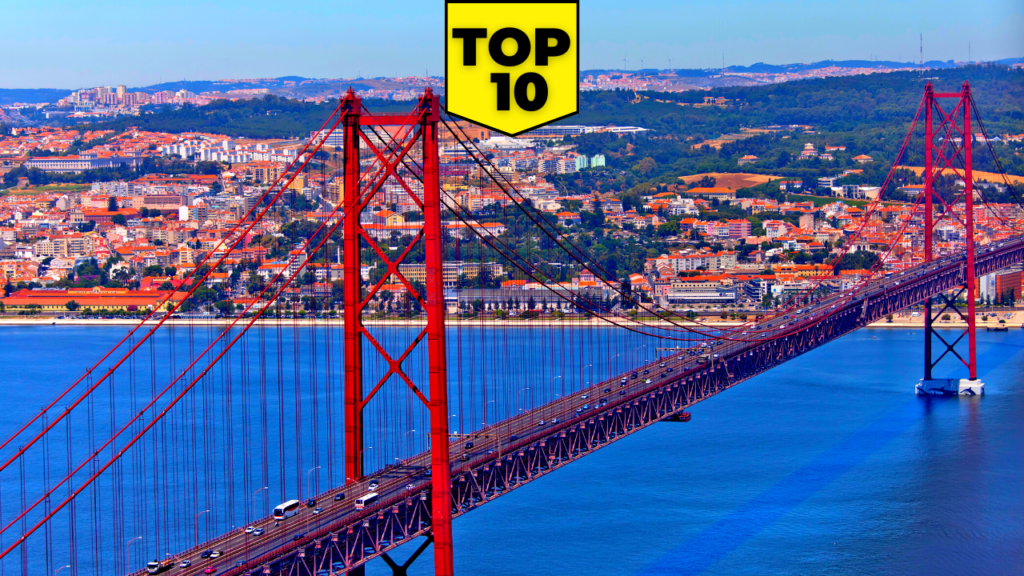
Lisbon is the largest city and capital of Portugal. Recognized as a global city because of its importance in finance, commerce, fashion, entertainment, arts, education, and international trade. But more significantly, it is the second-oldest city in Europe, second only to Athens.
With roots dating back to as early as 1,200 BC, imagine more than 3,000 years of history, encapsulated in this beautiful city. Remember, this is where the Age of Discovery began, so it is only fitting that it is your turn to discover it yourself.
Let’s dive right in! Here are the Top 10 Things To Do In Lisbon Portugal.
Table of contents
- 10. Trek to Historic Landmarks
- 9. Underwater Wonders at the Oceanarium
- 8. Sit Back and Relax at a Town Square
- 7. Sample the Mouthwatering Cuisine and Nightlife
- 6. Visit Churches and Monasteries
- 5. Sightsee or Surf at Sintra and Cascais
- 4. Walk and Explore Alfama
- 3. Witness the Majesty of Palaces and Castles
- 2. Marvel at Museums
- 1. Hop on a Tramcar and a Funicular
- Conclusion
10. Trek to Historic Landmarks
Jumpstart your journey with a beautiful view of the city. Torre de Belém, also known as the Tower of Saint Vincent, stands proudly where the Tagus River meets the Atlantic Ocean. The tower was built in the 16th Century by King Manuel I, it is a UNESCO World Heritage Site.
Perhaps the most iconic feature of the city, Torre de Belém waved goodbye to famed explorers like Vasco da Gama as they set out on their perilous journey of discovery around the world.
For those never to return, it was their last sight of home. Featuring water-swept surroundings, a dome-ceilinged top floor with defensive cannons, and lookout spots on the roof deck that offers a soaring view of the sea and the city.
And while in the area, pick up some Pasteis de Belem. The most famous in Portugal, this delectable pastry dates back to 1837, with a recipe that is still the same up to this day.
There are other historic landmarks dotting the city, like the Monument to the Discoveries, built in honor of the bold Portuguese expeditions, particularly in Asia and India. The massive triumphal gate in Rua Augusta. The fascinating Aqueduto das Águas Livres that was built in the 18th century. And many others. It is best to take a guided tour so that you won’t miss out.
9. Underwater Wonders at the Oceanarium
The Oceanario de Lisboa, the largest indoor aquarium in Europe, is one of Portugal’s most popular family-oriented spots. It is home to 16,000 animals. With 450 marine species like rays, barracudas, and sharks.
And like the diverse reach of the Portuguese Empire, the exhibits represent marine environments from around the world: from the rocky coasts of the North Atlantic, the kelp forests of the Temperate Pacific, to Tropical Indian coral reefs and even the Antarctic coastal line.
Meet shy moray eels, colorful puffer fish, and lovable penguins. There is also a boating lagoon where you can rent a pedalo, and have tons of fun with the kids or a loved one.
8. Sit Back and Relax at a Town Square
Witness the culture unfold by strolling through or sitting at one of Lisbon’s many public squares. One such plaza is the famous Rossio Square. The spot marks the very heart of the Pombaline Lower Town.
Now bookended by babbling Baroque fountains, the site is well-known since the medieval age, being the gathering area for the many revolutions, demonstrations, celebrations, bullfights, and even executions throughout its history.
There is also the Praça do Comércio facing the harbor, Praça do Comércio, and other public squares.
7. Sample the Mouthwatering Cuisine and Nightlife
A perfect spot to savor the local cuisine. Mercado da Ribeira is a huge indoor market near the Tagus River and is the main food market in Lisbon. It opened in 1892, and for more than a hundred years, this is the place for getting fresh seafood, fruits, and vegetables.
Nowadays, it features a large food hall and numerous restaurants, where the best Lisbon chefs serve you an endless array of local and international specialties. On its second floor, you’ll find the more modern eateries.
Get to sample Lisbon’s iconic specialty, the Pastéis de Nata or Portuguese custard tarts, as well as sip fine Portuguese wine. There are also stalls offering souvenirs and handicrafts.
At night, you can indulge at Bairro Alto and Alcantara, both packed with al fresco cafes, authentic pastelaria bakeries, and international restaurants.
Bairro Alto in particular is the city’s top nightlife spot with bohemian drinking joints offering a glimpse of Fado. Developed in the 1820s in Lisbon, this art form was registered by UNESCO as an Intangible Cultural Heritage of Humanity.
6. Visit Churches and Monasteries
Portuguese missionaries played an important role in expanding Portugal’s power during its imperial days, and the city has numerous churches, monasteries, and religious monuments to visit.
Lisbon Cathedral is the most iconic landmark and oldest church in Lisbon. Built in the 12th century, it features a religious nave, sanctuary, transept, gothic tombs, and ancient cloisters.
You can also visit the Jeronimos Monastery, famous for its ornate spires and grand carvings. The gorgeous domes of the Basílica da Estrela. Or even the ruins of the Convento do Carmo. Among many others.
5. Sightsee or Surf at Sintra and Cascais
A town less than an hour’s drive from the city center, Sintra is a favorite weekend and holiday destination. With an abundance of luxury resorts, villas, and restaurants.
In the 19th century, King Ferdinand II turned a ruined monastery into a castle, establishing Sintra as the first center of European Romantic architecture.
A favorite vacation spot for the nobility and the upper class, Sintra is dotted with elegant churches, colorful mansions, manicured gardens, and the palaces of former Portuguese rulers, all speaking of Sintra’s grandeur.
It also has several beaches with perfect conditions for surfing and windsurfing. Although it’s in a different city, ask anyone from Lisbon and he or she would recommend that you visit it. You can get to it either by car, train, or guided tour.
Similar to Sintra, Cascais used to be a small fishing village 30 kilometers away from Lisbon. In the 19th century, the Portuguese Royal family chose this beautiful place as a vacation destination.
This quaint coastal town has lovely beaches, a big yacht harbor, and attractions such as museums, art galleries, and the ruins of a castle!
4. Walk and Explore Alfama
The best way to immerse yourself in the surroundings is to walk across Alfama’s medieval streets that are lined with age-old, red-roofed buildings, historical monuments, and cultural heritage sites. Alfama is the oldest district of Lisbon.
This charming neighborhood has cobbled roadways that span across hidden courtyards, old churches, small squares, and fantastic architecture.
Be sure to bring your camera because Alfama can take your IG stories to the next level! Head over to the Miradouro de Santa Luzia garden or the Miradouro das Portas do Sol to enjoy a spectacular view of Alfama amid the backdrop of beautiful blue waters.
Alfama lets you meet the soul of this city. If you want to hear stories and understand the sites better, you can join a guided tour.
And if you want to stay there for far longer than a day, know that many traditional houses have been transformed into lovely rental apartments.
3. Witness the Majesty of Palaces and Castles
And while you’re at Alfama, you can check out Sao Jorge Castle. The former royal palace was built 2,000 years ago and has been used over the centuries by the Phoenicians, Carthaginians, Romans, and Moors.
This is where the Portuguese King welcomed Vasco da Gama after his historic journey to India. It is the best spot to get a commanding view of the city.
There is also the Ribeira Palace which was the royal residence of Portugal’s kings until it was destroyed by an earthquake in 1755.
The Grand Palace of the Marquises of Fronteira was built in 1681 and features regal gardens, sculptures, and even lakes! The Palacio da Bolsa with the statue of King Jose I, and many others.
2. Marvel at Museums
With thousands of years of history, and of course, its heyday during the Age of Discovery, Lisbon contains some of the most exciting and important museums.
The Museum of Ancient Art is the most popular. Housed in the 17th-century Palacio Alvor for over a hundred years, it showcases 40,000 ancient masterpieces and national treasures, some dating back to more than a thousand years!
At the National Tile Museum, trace the important history of tile making from hundreds of years ago, and see traditional blue-hued ceramic tiles called azulejos, with some dating back to the 15th century! These works gave the country its famous reputation for ceramic craftsmanship.
The National Museum of Ancient Art lovingly shelters Portugal’s prestigious national art collection. Most of the canvasses date from the Renaissance period and the Age of Discovery.
You can also visit the Museu do Oriente, and witness culture and art from the far reaches of Portugal’s great Renaissance Empire. With specimens from all Eastern corners of the empire.
There is also the Lisboa Story Centre, the Berardo Collection Museum, and various other museums housing the country’s rich history. You can drop by many of these museums as you tour different parts of the city by tram, tuk-tuk, or just a plain stroll.
1. Hop on a Tramcar and a Funicular
Soak in the romance of the city by hopping onto a tramcar. Tram 28 is most famous because of the attractions that you pass by along the 7-kilometer route, and also because of the tramcar itself — a charming, yellow Remodelado that dates back to the 1930s!
Hear the rattling of the rails as you wind through the narrow cobbled streets of 4 beautiful districts. From the hills of Graça, through the alleys of Escolas Gerais, and many more landmarks, before pulling up to a stop beneath the dazzling domes of the Estrela Basilica.
Discover decades of history as you roll across this unique, soulful experience. We suggest you get the 24-Hour Public Transport Ticket, as this covers unlimited rides for all tram routes, metro, and bus services.
But that’s just part of the Lisbon rail experience. You can also catch the similarly yellow-colored Funiculars that traverse the elevated parts of the city. Like Rome, Lisbon was built on seven hills. So riding a funicular gives you a glimpse of this majestic city. Catch the vintage Ascensor do Lavra, the oldest funicular in Lisbon, which dates all the way back to 1884!
And along the way, drop by the Santa Justa Elevator, a 19th-century industrial age marvel which lifts people that are heading from Baixa do Carmo and offers sweeping views of the Lisbon downtown area!
Conclusion
With so many other interesting things to do in Lisbon, it almost feels unfair leaving them out. However, this should help you with an idea of what to expect when visiting Lisbon Portugal.
Lisbon has so much to offer that I dare to say it would be a perfect destination for almost any tourist. Unless you don’t like good wine, delicious food, great weather, awesome beaches, and a lively night out, then Lisbon can be crossed out of your list.
These are the top 10 things to do in Lisbon Portugal. Now I would like to hear your opinion about this list. Did you find any of our picks interesting? Which of these places would you consider exploring on your next visit to Lisbon? Let me know your opinion. Shoot me a DM on Instagram. I’ll personally reply to you 🙂
Check out my YouTube channel if you would like to watch some of my other favorite picks.



